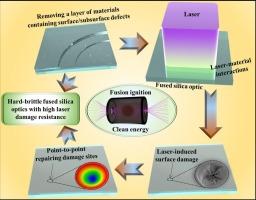提高硬脆熔融石英光学器件抗激光损伤性能的光学制造技术面临的挑战
IF 5
2区 物理与天体物理
Q1 OPTICS
引用次数: 0
摘要
高性能、高精度的熔融硅光学元件(如楔形聚焦透镜、连续相位板)是激光驱动惯性约束聚变(LD-ICF)设施的关键部件,该设施可提供兆焦和佩瓦的激光用于聚变点火。LD-ICF需要使用高质量、大孔径熔融硅光学元件来控制激光束的时间、空间和光谱,这对超精密制造提出了重大挑战。当这些熔融石英光学器件暴露于强激光脉冲时,可能会产生激光诱导表面损伤(LISD),并在随后的激光射击中迅速升级。这是制约LD-ICF提高输出能量的一个因素。LISD的根本原因是表面/次表面缺陷(SSD)。因此,根除SSD对于减少LISD启动和修复它们至关重要。针对这一问题,人们开发了各种技术,通过抑制SSD和修复LISD来提高熔融石英光学器件的抗激光损伤能力。然而,在实际应用中,这些光学器件的实际LDR仍然远远低于其原材料的固有阈值。对LDR改进技术进行全面深入的综述,为生产高性能熔融石英光学器件提供参考。本文综述了用于提高熔融硅光学器件LDR的尖端制造技术的发展。这些技术可能引入新的损伤前体(如重定位和化学结构缺陷),限制了熔融硅光学器件LDR的进一步增强。重点讨论和分析了这些挑战及其解决方案,并探讨了LDR改进技术的未来趋势。本研究旨在为高性能熔融硅光学器件以及其他硬脆光学器件的制造提供基础和指导,从而推动LD-ICF的发展。本文章由计算机程序翻译,如有差异,请以英文原文为准。

Challenges of optical manufacturing techniques applied in improving the laser damage resistance of hard-brittle fused silica optics
Fused silica optics (e.g., wedged focus lenses, continuous phase plate) with high-performance and accuracy are key components in laser-driven inertial confinement fusion (LD-ICF) facilities which deliver megajoule and petawatt lasers for fusion ignition. The LD-ICF necessitates the use of high-quality, large-aperture fused silica optics to control laser beams temporally, spatially, and spectrally, posing significant ultra-precision manufacturing challenges. When these fused silica optics are exposed to intense laser pulses, laser-induced surface damage (LISD) might generate and then escalate rapidly during subsequent laser shots. This has been a limiting factor in the promotion of output energy in LD-ICF. The root cause of LISD is surface/subsurface defects (SSD). Therefore, eradicating SSD is essential to reduce LISD initiations and repair them. In response to this issue, various techniques have been developed to enhance the laser damage resistance (LDR) of fused silica optics by inhibiting SSD and repairing LISD. Nevertheless, the actual LDR of these optics in practical applications is still significantly below the intrinsic thresholds of their raw materials. A comprehensive and in-depth review of LDR improvement techniques is necessary to provide references for manufacturing high-performance fused silica optics. This paper summarizes the development of cutting-edge manufacturing techniques used to enhance the LDR of fused silica optics. These techniques might introduce new damage precursors (such as redepositions and chemical structure defects), constraining further enhancements in the LDR of fused silica optics. These challenges and their solutions are discussed and analyzed emphatically, and the future trends of LDR improvement techniques are explored. This study aims to provide a foundation and guidance for manufacturing high-performance fused silica optics as well as other hard-brittle optics, thereby propelling the advancement of LD-ICF.
求助全文
通过发布文献求助,成功后即可免费获取论文全文。
去求助
来源期刊
CiteScore
8.50
自引率
10.00%
发文量
1060
审稿时长
3.4 months
期刊介绍:
Optics & Laser Technology aims to provide a vehicle for the publication of a broad range of high quality research and review papers in those fields of scientific and engineering research appertaining to the development and application of the technology of optics and lasers. Papers describing original work in these areas are submitted to rigorous refereeing prior to acceptance for publication.
The scope of Optics & Laser Technology encompasses, but is not restricted to, the following areas:
•development in all types of lasers
•developments in optoelectronic devices and photonics
•developments in new photonics and optical concepts
•developments in conventional optics, optical instruments and components
•techniques of optical metrology, including interferometry and optical fibre sensors
•LIDAR and other non-contact optical measurement techniques, including optical methods in heat and fluid flow
•applications of lasers to materials processing, optical NDT display (including holography) and optical communication
•research and development in the field of laser safety including studies of hazards resulting from the applications of lasers (laser safety, hazards of laser fume)
•developments in optical computing and optical information processing
•developments in new optical materials
•developments in new optical characterization methods and techniques
•developments in quantum optics
•developments in light assisted micro and nanofabrication methods and techniques
•developments in nanophotonics and biophotonics
•developments in imaging processing and systems

 求助内容:
求助内容: 应助结果提醒方式:
应助结果提醒方式:


